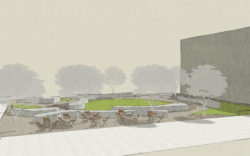Athens-Clarke County now has a Complete Streets policy, but will it apply to Prince Avenue?
Passed in December, Complete Streets signals ACC’s intention to accommodate all users—not just cars—when street changes are being planned, but it includes no specific projects or money. And in the meantime, ACC commissioners have explicitly excluded streetscape changes from an ongoing study and discussion about making zoning changes along Prince—an exclusion that doesn’t make sense to some participants.
The proposed zoning changes would loosen some square footage limits on new development and were recommended by last year’s Prince Avenue Corridor Study, along with transition zones between businesses and neighborhoods. But that study by county planners makes broad recommendations for Prince that go far beyond zoning tweaks: It recommends streetscape changes, accommodation of “bike routes along, across, and/or through” the entire length of Prince, protection of historic buildings and more greenspaces. So far, though, commissioners have only authorized moving forward on the new zoning category.
If Not Now, When?
“If you’re going to allow for more density and intensity of use along the corridor, make sure you have the infrastructure (in terms of traffic planning, pedestrian safety, protection of historic resources and other amenities),” wrote six members of a stakeholders committee Mayor Nancy Denson appointed to give feedback on the proposed zoning changes. County planner Bruce Lonnee, who has been working with the committee, told Flagpole that ACC commissioners had specifically directed planners at a work session late last year not to formulate any streetscape or traffic proposals for Prince.
“They didn’t want us to initiate anything with GDOT at this point,” he said, referring to the state Department of Transportation, which must approve streetscape changes, because much of Prince is a state highway.
The Oak/Oconee Street corridor, not Prince Avenue, will be the first test of the Complete Streets policy, Lonnee told Flagpole. Nor were members of the citizens’ committee encouraged to discuss historic preservation or transportation issues.
“They did come up from time to time” at the committee’s meetings, said Dan Lorentz, a committee member and president of the Boulevard Neighborhood Association, but “we all sort of understood that [zoning] was the scope” of the committee’s input.
“That’s a big, big problem,” said BikeAthens President Elliot Caldwell, who also served on the stakeholders committee. Several committee members and other citizens told the ACC Planning Commission earlier this month that zoning changes shouldn’t be considered in isolation from other Prince Avenue issues.
“You’re putting the cart before the horse,” said Tony Eubanks, a longtime Prince Avenue activist.
Planning commissioners seemed to agree: “Just picking land uses seems the wrong place to start,” said Chrissy Marlowe, citing dangers to pedestrians crossing Prince. “We’re just not having the right conversation right now.”
ACC commissioners need to apply the required resources to questions about Prince, planning commissioner Lucy Rowland said.
“I just don’t want this to drag out for years, because everyone will be frustrated,” she said.
Planning Director Brad Griffin has estimated that a Complete Streets analysis by his department could take 18 months; Griffin has insisted on spacing out assignments to his department after having them piled on in the past.
Nothing is likely to happen quickly on Prince. Commissioners’ reluctance to raise issues of traffic or preservation may smack of politics—and changes to Prince have certainly been controversial in past years, which is why they haven’t already happened—but bureaucratic inertia is a factor, too. Perhaps to space out planning department assignments, commissioners decided last year to limit the discussion to zoning only. Nobody seems to remember when that happened, or why—work sessions are open to the public, but they are not televised, no official notes are taken and there are no formal votes.
If Not This, What?
“Any project this extensive is going to be phased and prioritized,” Commissioner Kelly Girtz told Flagpole, but he didn’t remember the work session discussion.
“To be honest, I don’t recall the specifics,” agreed Commissioner Andy Herod.
If commissioners do decide to backtrack on a decision they don’t seem to recall having made, it will take awhile to undo it; the zoning question goes first to the planning commission, then back to the county commission no sooner than June.
There are precedents for avoiding discussions of Prince Avenue, which have brought political firestorms in the past. In 1998, then-Mayor Doc Eldridge’s campaign included adding bike lanes to Prince Avenue, but it never happened. A 2001 study by ACC’s transportation department (which had received “numerous” requests for bike lanes on Prince Avenue) concluded that reducing the street from four lanes to three and adding bike lanes would be “feasible” between downtown and Milledge Avenue; beyond Milledge, traffic counts are higher and the street is controlled by the state GDOT.
The lane change could be accomplished with no loss of on-street parking, the study said. But the proposal became politically charged, hysterical emails flew and then-Commissioner Hugh Logan orchestrated a dramatic vote that removed Prince entirely from the county’s long-term Bicycle Master Plan. Commissioner David Lynn subsequently defeated Logan at the polls, and a rather different group of commissioners later restored Prince to the bike plan. But the commission rejected three-laning and bike lanes on Prince in 2005.
Prince has also shown how negotiation can work to defuse conflicts like the threatened expansion of Athens Regional Medical Center into adjacent neighborhoods. In the early 2000s, CAPPA (Citizens’ Approach to Planning Prince Avenue), led by Eubanks, mounted a grassroots study to reimagine the entire corridor. It suggested adding trees along the right-of-way (as the county has since done) and parking lots, adding medians and bicycle lanes, putting utilities underground and turning some one-way street outlets into pedestrian malls. Some of CAPPA’s varied visualizations of Prince’s possible future are on view at www.historicboulevard.org. They influenced the county’s own 2012 Prince Avenue Corridor Study, which some feel that commissioners are ignoring along with the new Complete Streets policy.
That corridor study, developed by the ACC Planning Department, recommends increasing densities, both residential and commercial, along Prince.
“Increases in transit frequency and neighborhood-oriented and -scaled businesses both require greater residential densities to sustain these services,” it says.
“A detailed, master streetscape plan” should be developed for all segments of Prince Avenue, according to the study, and a traffic study should be done, with consideration given to mid-block crosswalks and “lane configuration changes” (presumably three-laning with bicycle lanes and perhaps taking control of Prince from the state with attendant maintenance costs).
Buildings on the Piedmont College and UGA Health Sciences campuses should be considered for historic protection, the study said, stronger greenspace connections and pocket parks should be developed and a new zoning category should be formulated for some parcels.
Meanwhile, a public hearing on the proposed Prince Avenue zoning changes will be held on Monday, May 20 at 7 p.m. at George Hall on the University of Georgia Health Sciences Campus.
Like what you just read? Support Flagpole by making a donation today. Every dollar you give helps fund our ongoing mission to provide Athens with quality, independent journalism.










